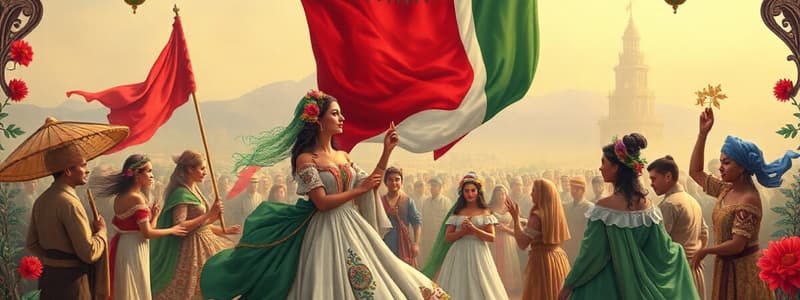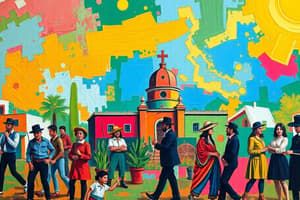Podcast
Questions and Answers
What year did Brazil gain independence from Portugal?
What year did Brazil gain independence from Portugal?
- 1806
- 1822 (correct)
- 1821
- 1889
Which celebration honors deceased loved ones in Mexico?
Which celebration honors deceased loved ones in Mexico?
- Cinco de Mayo
- Catrinas Festival
- Day of the Dead (correct)
- Carnival
Which civilization is known for its powerful military and flourished in central Mexico?
Which civilization is known for its powerful military and flourished in central Mexico?
- Inca Empire
- Maya Civilization
- Toltec Society
- Aztec Empire (correct)
What is a significant feature of Central American cuisine?
What is a significant feature of Central American cuisine?
Which event marked the start of Mexico's independence struggle in 1810?
Which event marked the start of Mexico's independence struggle in 1810?
Which art style is characterized by vibrant colors and geometric patterns in Central America?
Which art style is characterized by vibrant colors and geometric patterns in Central America?
What significant document was established in Mexico to enforce labor rights and land reforms?
What significant document was established in Mexico to enforce labor rights and land reforms?
What role does Catholicism play in South American culture?
What role does Catholicism play in South American culture?
Which of these genres is NOT included in Brazilian music?
Which of these genres is NOT included in Brazilian music?
What was the Brazilian Republic established after?
What was the Brazilian Republic established after?
What event marks the beginning of the Mexican Revolution?
What event marks the beginning of the Mexican Revolution?
Which of the following foods is traditionally associated with Día de los Muertos?
Which of the following foods is traditionally associated with Día de los Muertos?
What best describes the term 'Syncretism' in the context of Mexican culture?
What best describes the term 'Syncretism' in the context of Mexican culture?
Who is known for leading the Spanish conquest of Guatemala in 1524?
Who is known for leading the Spanish conquest of Guatemala in 1524?
What was a significant factor influencing political instability in Mexico during the 19th and 20th centuries?
What was a significant factor influencing political instability in Mexico during the 19th and 20th centuries?
Which of the following represents a modern challenge faced by nations?
Which of the following represents a modern challenge faced by nations?
What do Sugar Skulls symbolize in Mexican culture?
What do Sugar Skulls symbolize in Mexican culture?
In what period did the United Provinces of Central America exist?
In what period did the United Provinces of Central America exist?
What is the primary purpose of Ofrendas in Mexican culture?
What is the primary purpose of Ofrendas in Mexican culture?
What popular sport unites people in South America?
What popular sport unites people in South America?
Flashcards are hidden until you start studying
Study Notes
Mexico
- Cry of Dolores: Miguel Hidalgo's 1810 call for independence, marking the start of Mexico's 11-year struggle.
- Mexican Revolution: A conflict transforming Mexico's political and social landscape that began on November 20, 1910.
- Influential Leaders: Included Madero, Villa, and Zapata during the revolution.
- Constitution of 1917: Established labor rights and land reforms.
- Cinco de Mayo: Commemorates the Mexican victory over French forces in 1862.
- Mexican Independence Day: Celebrated on September 16th annually.
- Day of the Dead: A celebration honoring deceased loved ones, held on November 1-2.
- Ofrendas: Altars created to honor the deceased with offerings.
- Cempasúchil: Marigolds used to guide spirits back to the living.
- Catrinas: Stylish skeleton figures representing life and death.
- Pan de Muerto: Sweet bread symbolizing the body and soul.
- Mole: Rich sauce made with spices and chocolate.
- Pozole: Hearty stew made with hominy and meat.
- Tamales: Steamed corn parcels filled with various ingredients.
Central America
- Spanish Colonial Rule: Established in the 16th-17th centuries.
- Spanish Conquest: Began in the 1520s with Hernán Cortés.
- Pedro de Alvarado: Led the Spanish conquest of Guatemala in 1524.
- Independence Movements: Central America declared independence from Spain in 1821.
- United Provinces of Central America: Formed from 1823-1838, later dissolved into nations.
- Central American Art: Known for vibrant colors and geometric patterns.
- Central American Cuisine: Reflects a colonial past, incorporating corn, beans, and seafood.
- Central American Music: Includes traditional marimba and contemporary salsa.
South America
- Indigenous Heritage: Home to diverse indigenous peoples with unique traditions.
- Indigenous Beliefs: Rich spiritual heritage among indigenous peoples.
- European Colonization: Significantly impacted South America's culture and society.
- Spanish Influence: Combination of Catholic traditions with indigenous beliefs.
- Portuguese Influence: Established a large colony in Brazil, influencing culture.
- Cultural Exchange: Blending of indigenous and European cultures.
- Cultural Mosaic: Diverse geography influences various ethnic traditions.
- Catholicism: Dominant religion shaping South American culture.
- Amazon Rainforest: Home to vast biodiversity and unique ecosystems.
- Biodiversity: Region's rich variety of plant and animal life.
- Pantanal: Vast wetland known for diverse wildlife.
- Brazilian Independence: Gained independence from Portugal in 1822.
- Brazilian Republic: Established in 1889 after a revolution.
- Brazilian Art: Known for vibrant colors and energetic expressions.
- Brazilian Beaches: Stunning coastlines extending from Rio de Janeiro to Salvador.
- Brazilian Literature: Explores history and culture through notable authors.
- Brazilian Music: Includes samba, bossa nova, and forró genres.
- Soccer: Most popular sport in South America, uniting people.
Additional Points
- Pre-Hispanic Roots: Origins of many cultural practices trace back to ancient Aztec cultures.
- African Roots: Enriched culture through music, dance, and cuisine.
- Syncretism: Blend of Catholic and indigenous beliefs in spirituality.
- Modern Challenges: Nations strive for democracy and economic development.
- Resistance and Rebellions: Occurred in the 18th century against Spanish colonialism.
- Community Involvement: Events preserving traditions for younger generations.
Studying That Suits You
Use AI to generate personalized quizzes and flashcards to suit your learning preferences.




